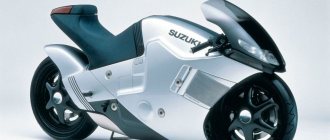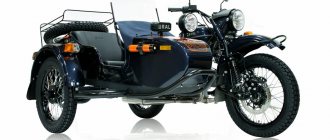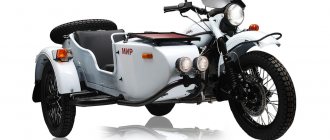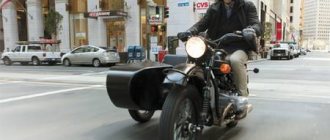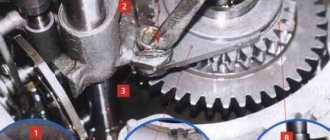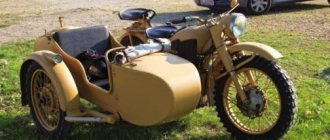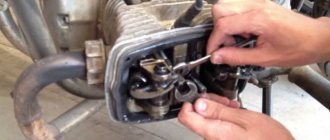All-wheel drive motorcycles are nothing new or unusual. They were created quite a long time ago, and similar vehicles were used mainly to participate in rally-type motorcycle racing. First of all, this is due to the fact that such models cope much better with turns at high speed.
However, unlike four-wheel drive vehicles, a four-wheel drive motorcycle does not have a full-fledged driven front wheel. On the most common models of this type from the Yamaha and KTM brands, only 20% of the power is transmitted to the front wheel. Christini's company was able to create a bike with 50 percent of the power transferred to the front wheel, but this greatly increased the weight of the vehicle. What can domestic models oppose to all this? We will talk now about all the advantages and disadvantages of the Ural all-wheel drive motorcycle .
A little history
Those who like to have a blast on a two-wheeled “iron horse” know for sure that for active recreation, country trips and overcoming dense off-road conditions, there is nothing better than all-wheel drive motorcycles. Among them is the Ural motorcycle, equipped with all-wheel drive.
Few people know that the first all-wheel drive motorcycle appeared almost 100 years ago in the UK. It existed in its class for quite a long time, without serious competitors.
A good ten years later, at the beginning of 1931, BMW began producing not only civilian bikes, but also began producing heavy all-wheel drive motorcycles for military purposes. Many people believe that all-wheel drive appeared due to the needs of the army, where in the distant times of World War II they were extremely necessary. An equally popular brand of motorcycles of that time was the famous Zundapp.
The prototype of the heavy Soviet Ural motorcycles was the above-mentioned units, in particular the R71 model. And so, in 1941, the first heavy motorcycle M72 rolled off the assembly line of the Irbit motorcycle plant, which immediately became part of the equipment for service with the Soviet army.
What happened next
The year 1957 became famous for the fact that the first small batch of all-wheel drive Urals, which were three-wheeled models, was produced. And the M61 became such a motorcycle, completely adopting the chassis design from the 72nd model. It began to be equipped with an overhead valve engine.
A little later, the plant mastered and added an important innovation in the form of reverse gear, which was completely absent on motorcycles with lower valve engines. An example of this is the earlier model - K650.
Gradually, the all-wheel drive Ural motorcycle underwent design changes. In addition to modifications to the engine and the introduction of reverse gear, a fundamentally new carburetor was installed, as a result of which the engine power increased. Subsequently, modern models began to be equipped with high-quality Japanese-made carburetors (“Keihin”). The Ural motorcycle received improved dynamic characteristics and high braking quality thanks to the installed disc brakes, which are considered one of the best in the world.
Characteristic features of all-wheel drive units
The Ural motorcycle (see photo above) can safely be called the only motorcycle with a sidecar in the world, which is produced with a non-differential switchable drive. One of the models of Irbit manufacturers was the Patrol motorcycle, which has a switchable sidecar wheel drive. The patrol with a lightweight T-version enjoys considerable success far beyond the borders of Russia. Thus, according to sales results in 2012 alone, 37% more cars were sold than in 2011.
“Patrol” can cope with any off-road conditions, as it is equipped with a 4-speed gearbox. All-wheel drive Ural motorcycles overcome the most difficult sections of roads. So we can say with confidence that this is the best road bike. And indeed, being loaded, it will never let the driver down, under any circumstances. That is why Americans, always skeptical, have great respect for the Ural Patrol. The cost of the Patrol-T model fluctuates around 300 thousand rubles.
What about the all-wheel drive Ural?
In principle, such a vehicle has never been officially released. Thus, it will not be possible to purchase a production model. However, one Russian craftsman managed to independently create a Ural with a wheelchair drive, which copes well with difficult sections of the road. A radiator from a VAZ 2106, as well as two additional electric fans, are mounted on such a vehicle. You will also need a 63 amp battery and a homemade transmission mechanism.
It is worth saying that this version of the Ural wheelchair drive is the most universal and allows you to achieve excellent cross-country ability and reliability. As a result, many began to inherit and copy such a creation, so that now you can see a fairly large number of similar vehicles.
Unfortunately, manufacturers do not always listen to the wishes of customers, so the Ural motorcycle with a sidecar drive has not yet entered mass production . Well, perhaps in a few years they will begin to produce it en masse, but for now we should be content with homemade models.
Comfort and relaxation with “Tourist”
The “Tourist-2WD” model (Ural motorcycle) was created especially for Russian roads, which have not seen a replacement for ages. The all-wheel drive of this monster allows you to overcome not only domestic off-road conditions without any problems, but also accelerate along the highway to a speed of 120 km/h, while spending only 7 liters of gasoline for every hundred kilometers.
It’s easy to guess that the Ural motorcycle of the Tourist line is designed for long trips, and for this it is equipped with everything necessary. If desired, the drive of the stroller is turned off and it is disconnected. In this case, you can travel only on two wheels, but this will not make your impression of the unit any worse.
Four-wheel drive motorcycles of the Tourist series are equipped with 45-horsepower engines with a displacement of 750 cm³. At the same time, the cars accelerate to 120 km/h in a matter of seconds ─ as fast as Yamaha sports motorcycles, the prices of which can exceed half a million rubles. Please note that this is with a motorcycle weight of 335 kg, and you can take almost the same amount of equipment and cargo with you in weight, fortunately it has enough “horses” to easily pull such luggage. The fuel tank is designed for 19 liters of fuel, and the consumption is generally ridiculous: in highway conditions - up to 4 liters, and in the urban cycle does not exceed 7 liters for every 100 km.
Cross-country Urals with a sidecar
Irbit “sidecars” The Irbit school of motorsports (category “Ural motorcycle with sidecar”) is one of the best in the country.
It has existed for more than 60 years, starting in 1945. Irbit racers have more than 200 gold medals, 59 athletes became champions of Russia and the USSR. Some have won the high title more than 10 times. Start
The first train with equipment from the Moscow Motorcycle Plant arrived in Irbit on November 17, 1941. The evacuation of enterprises, carried out out of necessity during difficult war times, determined the fate of a small Ural town located on the banks of the river of the same name. The abbreviation IMZ (Irbit Motorcycle Plant) became known throughout the country, and motorcycle racing became one of the main interests of Irbit residents.
The first M72 motorcycles produced at IMZ were sent to the front in early 1942. And the first cross-country race in the city was held during the war. On June 25, 1944, about ten riders took part in demonstration performances. The races were carried out in single M-72 cars; two foreign cars also took part – Royal Enfield J. and BMW R-71.
The first "official"
In 1945, the first official motocross took place on M-72 cars. It became “official” due to the fact that the city committee of the All-Union Communist Party of Bolsheviks took part in its organization. The date June 17, 1945 began to be considered the birthday of Irbit motorsport. About 20 single riders took part in the competition. And only one motorcycle had a sidecar. It was driven by young motorcycle testers Veniamin Gubin and Alexey Dubskikh.
To the delight of the Irbitsk residents, they showed a very good result, only slightly losing to the winner. Why did their motorcycle have a sidecar? Legend says that the reason for this was Gubin’s short stature, whose legs could hardly reach the ground.
Gubin and Dubskikh carried out the first modification of the side trailer. On ditches and ruts, the back of the stroller touched the ground, so it was decided to part with the luggage compartment. As a result, the “boat” became shorter.
Victories of Irbitsk residents at union and republican championships
At the USSR Championship in 1945, Irbit entered 5 crews in the wheelchair class. The competition took place on the 23rd km of the Minsk highway, in the vicinity of Moscow. The Irbit plant team won the 300 km linear race. The crew of Igor Okunev and Alexey Antropov performed especially successfully on the modernized M-75. They set a Union record for completing a 300 km route. The distance was covered in 2 hours 56 minutes. 9.9 s., which was more than 30 minutes higher than the previous record. In second place was the already well-known crew of Veniamin Gubin and Alexey Dubskikh on the M-72. Their main victories remained ahead. They still had to become prize-winners and champions of the RSFSR and the USSR.
In preparation for the 1947 national championship, which was to be held in two disciplines - “cross-country” and “ring” - special sports strollers were manufactured at IMZ (for the first time on an industrial basis). They were called "TT" - after the famous Tourist Trophy race held on the Isle of Man. The stroller was universal, i.e. was designed for road racing and cross-country.
Before the Union Championship, the RSFSR Championship was held in Serpukhov, in which 6 Irbit crews participated on updated motorcycles. The absolute winners were Alexander Lukoyanov and Nikolai Sachkov. The competition participants had to overcome some climbs “manually,” that is, dragging their motorcycles with their hands.
The M-75 engine was installed in the lightweight chassis of the road car, and the cross modification was equipped with the M-72 engine. The modernized technology did not disappoint. On it, the Irbit crew Alexander Lukoyanov/Nikolai Sachkov became champions of the RSFSR in cross-country and linear road racing. They repeated their brilliant performance in Tallinn at the USSR Championship, becoming winners in the “ring” and second in the “cross”.
The need for modernization
The competition showed that the TT stroller needed improvement. The rigid wheel suspension (“two-spong”, as the racers called it) was a drawback. A more advanced torsion bar suspension appeared later - in the early fifties.
The cross country tracks of that time were not like those of today. They were laid along country roads, fords, ravines, and swamps. Racers often had to pull their cars out of the mud with their hands. For this purpose, motorcycles were equipped with various devices, such as handles on the rear and front guards. For the convenience of the wheelchair user, who was kneeling, the stroller was equipped with a special seat on which he could rest a little while passing through flat areas.
The length of one lap of the track was 25-50 km. The full distance (50-100 km) consisted of several laps.
In the Urals, winter lasts a long time - from November to April. Therefore, winter racing is commonplace for Irbitan racers. The routes were laid over rough terrain. Horse roads, which had a limited width, also fell into their zone. This led to the side trailer moving across the virgin soil, braking the motorcycle. The problem was solved by installing a metal ski instead of a stroller wheel.
Racing M-72K and M-61K
Not only the racers themselves, but also engineers from the IMZ design department took part in improving the design of racing motorcycles. Various modifications of cars were developed, specifically designed for racing. The production of small batches of the M-72K cross-country model began in 1952. The car was intended for leading racing clubs. One of the features of the M-72K was the air intake located in the upper part of the gas tank. This decision was due to the fact that fording rivers was an invariable component of motocrosses of those times.
Ural Motorcycle Plant
produced the M-72K for six years. From 1952 to 1958, just over 300 copies were produced. However, even a special racing motorcycle could not avoid modernization by the riders themselves. The spark plug suspension of the rear wheel was equipped with a friction shock absorber, a hydraulic damper was installed, etc.
The next sports model was the M-61K, produced in 1959-1965. It was equipped with an overhead valve 650 cc M-61 engine with 28-30 hp. The stroke of the spark plug suspension was increased by 20 mm. A total of 855 motorcycles were produced - not counting those that were made specifically for their Irbit riders. In addition to the M-61K, the M-52K was also produced - based on the M-52 engine with a displacement of 494 cm³.
Championship 1962: all medals for IMZ crews
In the early 60s, Irbit was already a generally recognized leader in motorsport in the sidecar class. The result of this was that the city was entrusted with hosting the USSR motocross championship. By this time, racing tracks had changed radically. From hundreds of kilometers of broken and mud-filled roads, they turned into 2-4 km long circles with a set of natural obstacles, convenient for spectators to view. The IMZ team received a new, modern and high-speed vehicle, the Cross-650. High-speed Ural motorcycle engine
(up to 6,000 rpm), 40 horsepower, rear swingarm, weight reduced by 15 kg. The wheelchair seat disappeared; he no longer had time to rest.
38 crews took part in the competition, 9 of which had previously become national champions (the driver inherits the title of the crew). These were Evgeny Kosmatov from Moscow, Alexander Razorenov and Yuri Sokolov from the Investigative Committee of the USSR Armed Forces, Vladimir Volchkevich from Leningrad, Irbitsk residents Genrikh Vartanyan, Veniamin Gubin, Anatoly Bykov and others. The result exceeded all expectations of the audience. In the class of 350 “cubes” and above, the entire podium was occupied by representatives of one team – IMZ. Henrikh Vartanyan and Viktor Karzhavin became champions of the USSR, silver went to Leonid Leshkov and Evgeniy Korolev, third were Veniamin Gubin and Gennady Borodin. Exactly the same Gubin who performed back in 1945.
Unsuccessful M64-K
The new 1969 750 cc M-64K, which had a lever front fork and an enlarged steering column bearing, turned out to be unsuccessful. All four crews of the factory team at the Union Championship in Vilnius left the track due to the same malfunction - a jammed steering column bearing.
First trip abroad
Until the early seventies, our “strollers” did not participate in international competitions. The first trip abroad took place in 1971 - to participate in three stages of the forerunner of the European FIM Cup championship. The team had three crews - two from Irbit (Anatoly Sibirtsev, Igor Nikonov, Valentin Telegin and Pyotr Sosnovskikh) and one from Moscow (Valery Alfeev and Alexander Kuzovkin). The racers competed on IMZ “Cross-750” models with a power of 45 hp. The performance was considered not entirely successful. Although it couldn’t be called a failure, since Soviet crews were consistently in the top ten. In fact, it couldn’t have been any other way. Rival motorcycles were 30-40 kg lighter and 15-25 hp. more powerful.
Our riders were especially impressed by their sidecars. Not only were they 15-20 kg lighter than ours, but they were also much more convenient to use. The skilled Pyotr Sosnovskikh and Igor Nikonov very carefully studied the nuances of foreign technology and took measurements. Fortunately, foreign teams reacted to our interest with understanding and kindness. By the way, Soviet motorcycles, for their part, also surprised them a lot - with their “tank-like appearance”.
Proved
The next year, our teams competed at the stage in Belgium on “civilized” motorcycles. The result was completely different from last year. Anatoly Sibirtsev and Igor Nikonov took first place, and Valentin Telegin and Pyotr Sosnovskikh took third.
Newly shaped strollers in Irbit began to be called “Swedish”. Their advantages over the old ones were undeniable. It has become much more convenient and safer for the second number to help the driver during jumps and on turns (especially on the right). In the previous design, it was necessary to load the rear of the stroller and help the driver steer the front wheel in the desired direction. It was not easy to do this physically. In a “Swedish” stroller, the front part is loaded, which makes the rear wheel lighter, which leads to a slight slip. Thanks to centrifugal force, the right turn is easier to navigate. At the bottom of the arch attachment there was a loop, to which the wheelchair user clung with his foot when passing a left bend.
Organizational innovations
In the bureaucratic offices, a decision was born in 1977 to hold the national championship in two classes - “national” (up to 650 cm3) and “free” (up to 1000 cm3). At the same time, in the “1000” class, no design restrictions were introduced - except for the ban on using components and parts of foreign-made machines. But in the “650” class everyone was required to compete only on serially produced M-63K motorcycles. All changes to cars were prohibited.
The purpose of the innovation was to put everyone on an equal footing. However, in reality this meant a step back. Leading riders by that time were racing on motorcycles with a “Swedish” sidecar, a pendulum fork, a reinforced reverse gear, Czech carburetors, and a closely aligned gearbox. Now they had to abandon everything that the route necessity had led them to.
The results of the 1977 championship were dismal. The strongest racers, accustomed to taking risks on the track, retired for various technical reasons. And those who practiced a soft walking style of driving without overloading the machine and without risk received credit.
The results of the competition forced sports officials to relax. This especially affected the 650 class. They allowed reinforced reverse gears, a pendulum fork, and a “Swedish” stroller. But permission for a closer checkpoint was not given.
In pursuit of speed, some racers tried to circumvent the prohibitions. In the serial gearbox, the standard reverse gear (“eight” - based on the number of teeth on the shank) was changed to “seven”. Bans in the “1000” category on foreign components were also sometimes circumvented. Bilstein gas-filled shock absorbers, which performed well, for example, were disguised as homemade products.
Cancel restrictions
From the second half of the 80s, when it became clear how far Russian racers were behind foreign athletes, all restrictions were lifted. This led to immediate change. The 650 class has been transformed. The serial frame was replaced by a special lightweight one, the travel of the rear wheel and the sidecar wheels increased. A little later, disc brakes, a “progressive” mono-suspension for the rear wheel, etc. appeared. The IMZ experimental workshop produced 10-20 improved cars per year, ensuring complete dominance of Irbitan racers in the 650 class since 1987. The presence of representatives of other teams on the podium was sporadic.
“Unsinkable” IMZ-8.201
In the 70s and until the mid-80s, IMZ produced special motocross cars with 750 and 1000 cm3 engines for the country's leading racers. They were produced in limited quantities at the request of TsAMK in the experimental workshop. Our riders competed in them at domestic championships and European and world championships.
At the same time, the plant continued to produce mediocre IMZ-8.201. Receiving such “cars”, DOSAAF wondered why Irbit, having a modern Ural cross-country motorcycle
, continues to supply them with such squalor.
To be fair, it should be said that IMZ tried to establish mass production of truly modern machines with which one could achieve good results without at the same time putting one’s health at risk. However, departmental and ministerial approvals, limits, permits and clarifications, which were characteristic of Soviet industry, plunged all these attempts into a bureaucratic quagmire. As a result, serial IMZ-8.201 was produced until 1992 in the amount of 500-1000 units annually.
The last 5 cars were produced in 1992. And only the collapse of the Soviet Union stopped the production of the “unsinkable” cross-country bike, which was more suitable for fishing or hunting trips than for motorcycle racing.
A little about the 67th model
Heavy all-wheel drive motorcycles are especially revered among bikers and motorcycle enthusiasts. Let’s be honest, power and zeal are the adrenaline without which it’s hard to imagine riding a two-wheeled steel horse. This is the Ural series 67-36. What a machine! In terms of cross-country ability, only the Dnepr MT can compare with it in its class. The engine is so picky that it won’t be especially offended by its owner if he doesn’t add oil on time.
The 67th Ural accelerates to 100 km/h quite quickly, despite the fact that it weighs 330 kg and you can load another quarter of a ton on top. For every 100 km of mileage, fuel consumption is 8 liters, which is generally not bad, considering its power. The engine produces 36 hp. with a maximum torque of 4900 rpm. In general, the car is reliable in every sense, and it doesn’t lack endurance.
Five random articles about motorcycles:
Troubleshooting Tips for Java Motorcycles
For those who ride Java motorcycles The editors receive many letters from Java motorcycle owners.
They ask for advice on troubleshooting problems that appear during operation. The editors turned to experts and are publishing their answers to these questions. The mechanic of the Moscow workshop for warranty repair of Java and Chezet motorcycles, V. T. BOIKO, tells the story. About malfunctions of the clutch mechanism, gearbox and kick-sterter Clutch mechanism. If a correctly adjusted clutch does not engage smoothly, but jerkily, then to determine the defect it is necessary to disassemble the clutch. First of all, remove the left cover. The shift pedal does not need to be removed before this: it should be installed in the gear shift position, and not in the engine start position. The pedal is removed along with the cover and shift shaft (be careful not to lose the release shaft cover). Before removing the cover, drain the oil from the gearbox housing or place the motorcycle on its right side, first... Read more >>
Check the head and pipe. After engine repair on IZ Jupiter, gases leak from under the cylinder head
Check the head and pipe. I know that some owners of IZH-Jupiter motorcycles note that after repairing the engine, gases leak from under the cylinder head and, as a result, power drops.
The complaint is fair. There is no seal between the head and the cylinder, so their mating planes must have close-fitting surfaces. For various reasons (uneven tightening of the head, careless handling, etc.), this condition is violated, and then a breakthrough of gases occurs along the joint. To restore the tightness of the connection, the surfaces should be ground. This requires a simple device. shown in the figure. It ensures the centering of the head (there is no corresponding collar on the cylinder). The device is made of two wooden planks assembled in a cross. It fits tightly into the cylinder like this. that the upper rounded part protrudes by 7 mm. Apply lapping paste (abrasive powder, perhaps... Read more >>
Extending the service life of the RP1S relay for motorcycles IZH-Planet 3, Jupiter-3
A more reliable method For some motorcycles IZH-P3, IZH-YU3, the electronic relay RP1S of the turn indicators is constantly turned on along with the ignition, which shortens its service life. It was suggested that it should only work when the turn indicators are turned on (in B.F. Demchenko’s book “Tips” for motorcyclists", published by DOSAAF, 1986 and the magazine "Behind the Wheel"), a minor modification of the relay by changing the power circuits and introducing two diodes.
However, they turned out to impair the clarity of the relay operation. In order to eliminate this drawback, I found a more reliable way to connect the relay with the same change in the power circuits, but without additional diodes. Instead of the standard turn signal switch, we install a P25 A light switch (it is sold in all auto and motorcycle stores) and connect it as shown in figure (b). Do not forget to seal the three additional terminals from the relay like the existing ones. A. KOROLCHUK Volyn region, village. Milushi Output stage of relay RP1S and... Read more >>
After boring the cylinder and installing new piston and rings, knocking noises appeared in the engine of the IZH motorcycle
".
the reason for which is unclear to me. What can be wrong?" - asks K. Simakov from Khabarovsk. It is most likely that the rings make a knock when they meet the edges of the windows, into which they fall slightly during the movement of the piston. This phenomenon, characteristic of two-stroke engines, leads to intense wear of the cylinder at the location of the windows, and sometimes to breakage of the rings. To eliminate their interference, remove the cylinder and rings. Remove the chamfers from the lower and upper edges of the windows using a file and sandpaper, as shown in the figure, and carefully remove the processing products. Blunt the outer edges of the rings on a lathe (in a arbor) or by hand with a file and sandpaper. After assembling the engine, if the work is done correctly, instead of knocking you should hear a slight rustling sound made by the rings when moving in the piston grooves and passing through the windows, indicating the normal operation of these parts.1974N03P18 Read more >>
“Ural Up Gear” ─ power in military style
Irbit developers did their best by creating their brainchild Gear Up-2WD. The Ural motorcycle (see photo below) of this series is made in a military style and is designed to overcome the most difficult terrain and off-road conditions. The ease with which the motorcycle overcomes difficult road sections and rough terrain is ensured thanks to the all-wheel drive design of the chassis, as well as full reverse gear.
It makes no sense to list the areas of application of a “militaristic” motorcycle. However, we note that you can drive it anywhere in any weather all year round. This powerful machine is not afraid of snow drifts, heavy rains, or knee-deep mud. The price of this all-wheel drive three-wheeled SUV ranges around 620 thousand rubles.
From “Ural” to “Arkhar”: 2x2 all-wheel drive motorcycles
The idea of creating an all-wheel drive motorcycle has bothered the minds of engineers all over the world since the appearance of the very first motorcycle. History has seen many different designs, including front-wheel drive ones, but few have reached serial production.
Why? Experienced pilots do not need front-wheel drive in principle - the entire school of enduro driving is built around rear-wheel drive, and even in racing, additional components that reduce overall reliability and increase weight have not taken root. Please note that even in the Dakar car classification, from time to time, it is not all-wheel drive vehicles that win, but rear-wheel drive buggies.
But if you don’t have sporting ambitions, and want to climb on a motorcycle where not every ATV can reach, then all-wheel drive can be a good solution. The disadvantages of any all-wheel drive all-terrain vehicle are a complex design, high unsprung masses, and, as a rule, modest travel of the front suspension, which put an end to high speeds, but not everyone needs them, especially if the goal is simply to get there or have fun.
Domestic motorcycle "Baksan" during an expedition to Mount Elbrus. Photo – Sergey Gruzdev
There are many implementations of the idea of an all-wheel drive transmission for a motorcycle in the world, one way or another trying to overcome the main disadvantages inherent in such a design, but we will first of all consider serial all-wheel drive vehicles that can be bought today. However, the most interesting one-piece vehicles with a 2x2 wheel arrangement are still worth mentioning.
For example, in Russia the all-wheel drive Ural motorcycle is very popular. Urals with all-wheel drive are not produced serially, limiting themselves to only additional drive to the sidecar wheel. But craftsmen make all-wheel drive Urals on their own: they unroll the rear axle gearbox and attach it to a fork, connect it to a car CV joint and a gearbox that takes power from the rear wheel cardan coupling through a chain.
The classic scheme for implementing all-wheel drive on a Ural motorcycle. Photo – Nemoy
Less often, homemade products are also built from simpler devices with a chain drive. It is more difficult to implement a 2x2 transmission on such motorcycles - you have to install an additional drive sprocket, drag a second drive chain through the entire bike, select a suitable bevel gear, install a CV joint and another gearbox, and then transmit torque to the front wheel with a separate chain. In addition, you have to invent a new fork, usually a parallelogram type, because a telescopic fork with a chain drive will not work.
The most striking example of such an all-wheel drive motorcycle, built with one’s own hands, is the “Baksan”, which climbed to the top of Elbrus in 2003.
Homemade all-wheel drive motorcycle "Baksan" with a chain drive and a parallelogram fork in the Tula Motor Museum
Western engineers go further and try to experiment with the type of drive, for example, using designs where a telescopic fork is paired with a variable-length cardan. A similar all-wheel drive scheme is used on production motorcycles, but we’ll talk about them below, but for now here’s a photo of one of the most famous all-wheel drive KTMs, albeit built by customizers.
All-wheel drive on this bike is implemented through a cardan that changes length following the stroke of the fork. Photo – Rev'it
Speaking of customizers, one cannot fail to mention the Wunderlich company, which specializes in the manufacture of tuning and accessories for BMW motorcycles. For the EICMA 2015 exhibition, the manufacturer prepared an all-wheel drive version of the R1200GSA touring enduro, equipping it with a hybrid power plant combining a 125-horsepower boxer gasoline engine and a 10 kW wheel motor with reverse gear.
The story with all-wheel drive BMW continued on April 1, 2017, when representatives of the Bavarian brand released a statement about the serial production of the R1200GS xDrive Hybrid, which, however, turned out to be a joke.
The Wunderlich R1200GS Hybrid offers an alternative solution to the issue of all-wheel drive on a motorcycle. Photo – Wunderlich
In addition to the relatively common designs described above, there are also absolutely crazy solutions, for example, the Australian Drysdale Dryvetech 2x2x2. This is not a mistake; there are really three twos in the name: in addition to all-wheel drive, the device also has both rotating wheels. This design was made possible due to the fact that this all-wheel drive motorcycle has no cardans or chains at all, only hoses through which a hydraulic pump drives fluid, driving the wheels. The steering is implemented in the same way.
A technomaniac's dream: a motorcycle with full hydraulic drive
As for serial all-wheel drive bikes, motorcycles with a 2x2 wheel arrangement are built in Europe and the USA, and in Russia there are several manufacturers. The first production all-wheel drive motorcycle was the American Rokon, which entered production in the late 60s and is still in demand all over the world. The chain front drive and 208 cc engine do not contribute to speed records, but, unlike others, the top version of Rokon is equipped with unique wheels.
1973 Rokon Trail Breaker with unique wheels. Photo – Antiquemotorcycle
Yes, they are not installed on all versions, but only on the top-end Rokon Trail-Breaker, but no competitor has such a feature: the wheels double as cans into which you can pour fuel. Or, if they are empty, with floats, thanks to which the motorcycle has a good reserve of buoyancy and, if necessary, can swim across the river. Such a device is not cheap - more than 450 thousand rubles, but it is worth it. The same Rokon offers simpler versions, for example, the Ranger model with a 160 cc engine can be purchased for 435,000 rubles.
A modern modification of the Rokon Trail-Breaker all-terrain vehicle. Photo – Сycleworld
Another serial all-wheel drive motorcycle that became a real legend during its lifetime is the Yamaha WR450F 2-Trac. Journalists predicted a great future for the bike, which was released in 2004, and called it almost a revolution in the world of two-wheeled vehicles, but, alas, the new product did not catch on. The nails in the coffin of the all-wheel drive enduro were driven by both the high price, almost twice the cost of its rear-wheel drive counterpart (the 2-Trac was not officially supplied to Russia, but enthusiasts themselves brought the devices from Europe for a fabulous 16,000 €), and the policy of the Japanese manufacturer that released the revolutionary motorcycle limited edition. However, there is still a theoretical opportunity to buy this model.
Yamaha WR450F 2-Trac – a fairy tale come true
From an engineering point of view, the Yamaha WR450F 2-Trac was and remains an outstanding representative of its class: while the drive of the rear wheel was carried out through a chain, torque was transmitted to the front wheel through hydraulics. And although the motorcycle’s transmission was not fully all-wheel drive, but, as is fashionable on modern cars, it was automatically activated when the rear wheel slipped, the 15% of torque that it supplied to the front wheel delighted everyone who was lucky enough to ride it. beast.
Front wheel drive engages Yamaha 2-Trac engages when rear wheel slips
The American Christini AWD 450 is another all-wheel drive motorcycle that can be bought new. The model range includes as many as five all-wheel drive models built around a 450 cc platform, among which, in addition to the usual enduro, there is a supermoto and a motorcycle for the army. They cost, depending on the configuration, from $8,500 to $14,000, have “street legal” status and, in theory, the possibility of obtaining a title in Russia.
However, the most interesting offer for our compatriots will not even be them, but the 300 cc all-wheel drive Christini AWD 300 for $7,995 and the Chrisitni AWD Framekit, which allows you to convert your motorcycle to all-wheel drive. The company offers a set of components for installing all-wheel drive on KTM two-stroke and four-stroke enduros produced between 2005 and 2011 for $3,995, as well as a kit for converting 250 and 450cc Honda motorcycles into all-wheel drive from 2005 to 2013 for $3 $595. The cost may seem high, but it's not: AWD kits for Honda and KTM include the frame, forks, a complete drivetrain kit for front-wheel drive, and a custom fuel tank.
Military tests of Christini AWD 450 Military
The mechanism for implementing the drive to the front wheel also deserves attention: power is taken from the drive sprocket by a chain and transmitted through the gearbox to the cardan running through the frame. In the steering column, an angular gearbox transmits power to two stars located directly in the front yoke, from where it, through two cardan shafts of variable length, comes to the front wheel gearboxes, of which, of course, there are two. Moreover, to minimize the gyroscopic effect, the cardans rotate towards each other!
It is difficult to imagine the mechanism for implementing a chain drive in a traverse, but, nevertheless, it exists!
And if buying a foreign car is expensive, you don’t want to farm collectively, but the desire to ride an all-wheel drive motorcycle does not fade, you should pay attention to domestic manufacturers - in Russia there are more brands involved in “all-wheel drive” vehicles than anywhere else. And even though they are still far from high technology, Russian all-wheel drive motorcycles perform their functions perfectly. The most popular device on the market today is the Tarus motorcycle.
The all-terrain vehicle is made extremely simply and reliably: there are no suspensions, the engine is powered by a generator, two gears, and the only disc brake is installed not on the wheels, but on the transmission. But in the most basic configuration, “Tarus” costs only 115,000 rubles, and in the top-end version, with a Honda engine, headlight and electric starter, 140,000 rubles. And it doesn’t matter that due to the lack of a title, such a motorcycle cannot be ridden on the roads, but it can be quickly disassembled and put in the trunk of a station wagon.
The domestic manufacturer offers a good alternative to Rokon for reasonable money
Vilar-Pro also produces all-wheel drive motorcycles. Structurally, their “Arhar”, which is the name of the model, is close to the “Tarus” all-terrain vehicle, but, unlike it, the manufacturer does not report anything about the characteristics of the bike on its website and does not name prices, although the motorcycle is presented at the “Motozima 2016” exhibition was.
Technical side
These all-wheel drive motorcycles are equipped with 41-horsepower two-cylinder four-stroke engines with a displacement of 745 cubic meters. The maximum speed that the car can reach is 110 km/h. Fuel injection is controlled by an injection system. The engine is started by an electric starter, and a kick starter is also provided for these purposes. The fuel tank holds 19 liters of gasoline, and fuel consumption is 7.5 liters per hundred kilometers.
The brake system of the motorcycle is represented by a hydraulic caliper, and the clutch is a dry-type double-disc mechanism. The telescopic front suspension ensures a smooth ride on off-road terrain. The presence of a differential-free transmission allows you to overcome obstacles of any complexity.
About ease of use
The khaki coloring will be invisible in the forest or in the reeds near a pond, so the “Ural Gear Up” can be safely equipped for hunting or put the necessary fishing gear in it. With a weight of 365 kg, you can take a lot of payload and luggage with you.
This model is significantly weighted by the developers, which allows you to transport everything you need and makes the car as stable as possible. Therefore, you can safely make maneuvers and not be afraid that the agegate may skid and it will turn over.
If necessary, it can be set to the parking brake or the sidecar wheel drive can be disconnected, thereby transforming the Ural into a two-wheeled bike.
Another domestic model
Dnepr-16 is another Soviet bike with a sidecar. The model stands out thanks to the rubberized stroller springs and a load capacity of 200 kg. Such a vehicle will be an excellent option for leisure and work.
You may also be interested in: Features of the Ant scooter
Let's sum it up
Ural motorcycles with all-wheel drive have proven themselves to be reliable off-road vehicles. This equipment is equipped with high-quality imported equipment, which is distinguished by its quality. That's why we can say that the Ural is an indestructible bike. Most motorcycle models contribute to a comfortable and safe ride due to their design features. Due to their heavy weight, these units have good stability and considerable load capacity. A powerful engine, chassis and suspension features allow you to easily overcome any off-road conditions.
In addition, modern Ural motorcycles have an attractive appearance, ergonomic design and a high level of comfort. The design of these machines allows you to move smoothly along the road. Despite its weight, the motorcycle quickly picks up the required speed. It’s not a shame to appear on a heavy, powerful “iron horse” at a biker’s rally or, riding out on a country road at night, to enjoy the long road and feel the thirst for speed.
